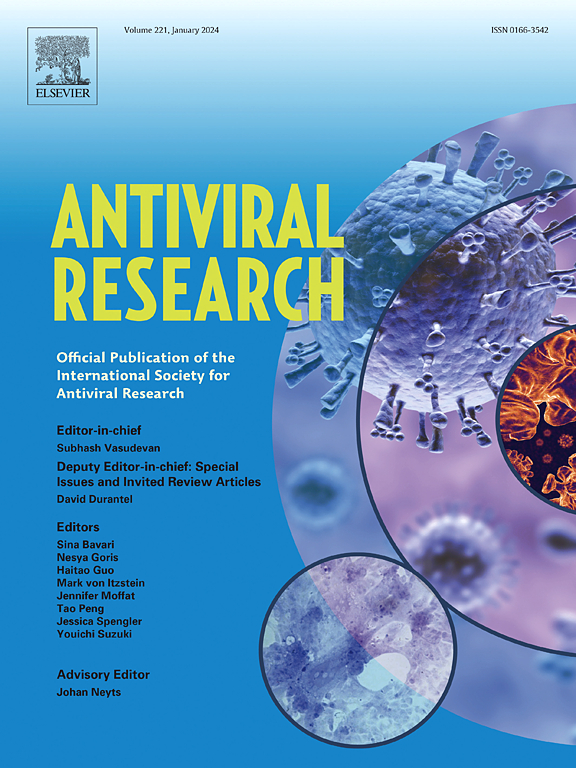广谱抗病毒药物BDGR-164对小鼠致死性嗜神经型甲病毒感染具有保护作用
IF 4
2区 医学
Q1 PHARMACOLOGY & PHARMACY
引用次数: 0
摘要
新世界甲病毒、东部马脑炎病毒(EEEV)、委内瑞拉马脑炎病毒(VEEV)和西部马脑炎病毒(WEEV)引起发热性疾病,可在人和马中发展为致命疾病。由于目前还没有被批准用于治疗人类嗜神经型甲病毒疾病的药物,我们报道了一种结构新颖的喹唑啉酮,BDGR-164,具有纳米摩尔效力,可治疗VEEV, EEEV和WEEV。在致死性BALB/c模型中使用鼻内途径的病毒感染来模拟生物防御情景下的气溶胶感染,与假药动物的统一致死率相比,预防性皮下给药BDGR-164可获得100% (VEEV)、88% (EEEV)和63%的生存率(WEEV)。利用RNA- seq和组织病理学,我们确定,与病毒感染的假治疗组相比,病毒感染的bdgr -164治疗组小鼠大脑中的病毒RNA水平和抗原显著降低。此外,bdgr -164处理的病毒感染小鼠的宿主免疫反应(与炎症信号、免疫细胞募集和程序性细胞死亡相关)显著减少。比较经bdgr -164治疗和未治疗的VEEV-、EEEV-或weev -感染小鼠血清中的细胞因子表明,较低水平的IL-6、TNF-α和RANTES水平与保护作用相关,可以作为动物模型治疗研究中有用的早期生物标志物。总之,我们的研究显示BDGR-164对嗜神经型甲病毒具有广泛而有效的预防作用。本文章由计算机程序翻译,如有差异,请以英文原文为准。
Broad spectrum antiviral BDGR-164 provides protection against lethal neurotropic alphavirus infection in mice
The New World alphaviruses, eastern equine encephalitis virus (EEEV), Venezuelan equine encephalitis virus (VEEV), and western equine encephalitis virus (WEEV), cause febrile illness that can progress to fatal disease in humans and equids. As there are no therapeutics approved for the treatment of neurotropic alphavirus disease in humans, we report a structurally novel, quinazolinone, BDGR-164, with nanomolar potency against VEEV, EEEV, and WEEV. Using an intranasal route of virus infection in a lethal BALB/c model, to model aerosol infection in a biodefense scenario, prophylactic subcutaneous administration of BDGR-164 conferred 100 % (VEEV), 88 % (EEEV), and 63 % survival (WEEV) compared to uniform lethality in sham-treated animals. Using RNA-Seq and histopathology, we determined that viral RNA levels and antigen were reduced significantly in the brains of mice from the virus-infected, BDGR-164-treated group as compared to virus-infected, sham-treated group. Moreover, there was a significant reduction in the virus-infected, BDGR-164-treated mice in their host immune responses associated with inflammatory signaling, immune cell recruitment, and programmed cell death. Comparison of cytokines in sera from VEEV-, EEEV- or WEEV-infected mice with and without BDGR-164-treatment suggested that lower levels of IL-6, TNF-α, and RANTES levels correlated with protection and may serve as useful early biomarkers in treatment studies in animal models. In conclusion, our studies show broad and potent prophylactic efficacy of BDGR-164 against neurotropic alphaviruses.
求助全文
通过发布文献求助,成功后即可免费获取论文全文。
去求助
来源期刊

Antiviral research
医学-病毒学
CiteScore
17.10
自引率
3.90%
发文量
157
审稿时长
34 days
期刊介绍:
Antiviral Research is a journal that focuses on various aspects of controlling viral infections in both humans and animals. It is a platform for publishing research reports, short communications, review articles, and commentaries. The journal covers a wide range of topics including antiviral drugs, antibodies, and host-response modifiers. These topics encompass their synthesis, in vitro and in vivo testing, as well as mechanisms of action. Additionally, the journal also publishes studies on the development of new or improved vaccines against viral infections in humans. It delves into assessing the safety of drugs and vaccines, tracking the evolution of drug or vaccine-resistant viruses, and developing effective countermeasures. Another area of interest includes the identification and validation of new drug targets. The journal further explores laboratory animal models of viral diseases, investigates the pathogenesis of viral diseases, and examines the mechanisms by which viruses avoid host immune responses.
 求助内容:
求助内容: 应助结果提醒方式:
应助结果提醒方式:


